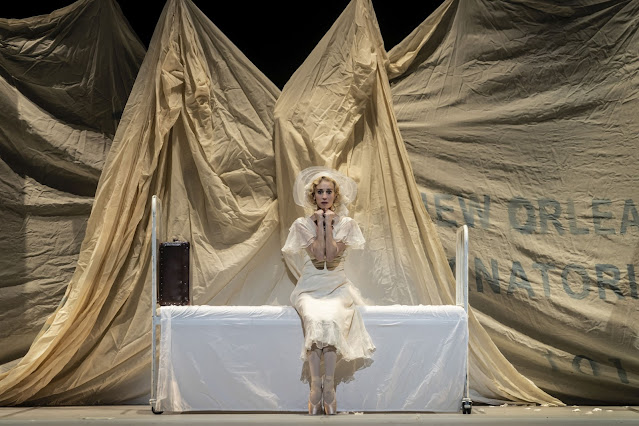 |
| Sonia Rodriguez as Blanche DuBois in A Streetcar Named Desire. (Photo: Johan Persson) |
Blanche DuBois, one of the most memorable female characters born of the theatre, is a hot mess of narcissism, nymphomania and other neuroses wrapped in white satin. A nervous breakdown just waiting to happen. The vaporous southern belle at the centre of John Neumeier’s ballet version of Tennessee Williams’s A Streetcar Named Desire requires a seasoned dancer who can peel back the layers to expose the fragility behind the tragedy of her fall. Sonia Rodriguez is that dancer.
Born in Canada, raised in Spain and trained in Monaco, the National Ballet of Canada principal is one of the country’s greatest dancer-actresses. She doesn’t just perform a part; she inhabits it, bringing it fully, palpably, to life. That’s her legacy, what she will be remembered for after leaving Canada’s largest ballet company following an illustrious 32-year career.
Her last shows took place at Toronto’s Four Seasons Centre for the Performing Arts last week, as part of the National Ballet’s ongoing winter season. There, over the course of three evenings, Rodriguez used her solid technique and emotionally resonant acting skills to command the stage as Blanche, the role she had requested as her swan song. She has finished her career on a high note, assuredly performing a challenging part while supported by her fellow artists in other main roles – Guillaume Côté as Stanley Kowalski, Jillian Vanstone as Stella, Brendan Saye as Mitch, Spencer Hack as Blanche’s husband Allan Gray and Ben Rudisin as Allan’s friend.
It wasn’t the easiest of exits to make. Neumeier’s ballet is marked by surreal scenes of decay and death as well as graphic depictions of sex culminating in a violent rape. The emotional journey is intense, to say the least. In two acts, Blanche goes from being a would-be bride to a patient in a psych ward. The shape-shifting is motivated by disillusionment, desperation and ultimately victimhood. It’s a role whose many fragmented parts combine to create a portrait of mental and moral disintegration. And Rodriguez did do it justice. She brought the tragedy to life, using her entire body as her dramatic tool.
Rodriguez’s finely controlled tremulousness mirrored the fragility of Blanche’s condition while her chameleon-like facial expressions captured the character’s panicked teetering between sanity and madness. It was an electrifying performance, a high-wire dance fraught with tension. Contributing to its success were the gaping silences in the first act, followed in the second by dissonant jazz and a strident score by Russian composer Alfred Schnittke, whose stabbing and jarring high notes gave sonic expression to Blanche’s inner turmoil. The choreography, combining athletic modern jazz idioms with lyrical classicism, similarly mirrored her schizophrenic unravelling.
Though primarily a showcase for a singular female dancer, the two-hour ballet was propelled by a series of pas de deux, ensuring Blanche rarely danced alone. It’s what made her final solitary moments on stage all the more poignant. Rodriguez animated the scene with delicate hummingbird vibrations, giving striking expression to a tortured state of mind. Blanche’s dénouement was the ballerina’s shining moment. summoning all her expressive powers in a final display of riveting artistry. It made for a touching farewell.
– Deirdre Kelly is a Toronto-based journalist, author and internationally recognized dance critic and style writer on staff at The Globe and Mail newspaper from 1985 to 2017. She writes for Dance Magazine in New York, the Dance Gazette in London, and NUVO in Vancouver, and is a contributor to the International Dictionary of Ballet and AWOL: Tales for Travel-Inspired Minds. The best-selling author of Paris Times Eight and Ballerina: Sex, Scandal and Suffering Behind the Symbol of Perfection, she is a two-time recipient (2020 and 2014) of Canada’s Nathan Cohen Prize for outstanding critical writing. In 2017, she joined York University as Editor of the award-winning The York University Magazine where she is also the publication’s principal writer.

No comments:
Post a Comment